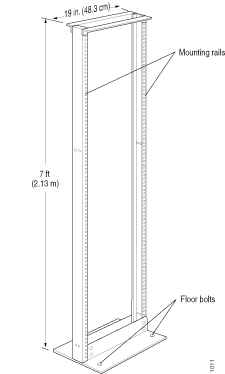MX960 Rack Requirements
The router can be installed in many types of racks, including four-post (telco) racks and open-frame racks. An example of an open-frame rack appears in Figure 1.

Rack Size and Strength
The size, strength, and location of the rack must accommodate the router's weight and external dimensions. The location of the rack must allow for the clearance requirements specified in Clearance Requirements for Airflow and Hardware Maintenance for the MX960 Router.
The chassis is 17.37 in. (44.11 cm) wide. The router is designed for installation in a standard 19-in. rack, as defined in Cabinets, Racks, Panels, and Associated Equipment (document number EIA-310-D) published by the Electronic Components Industry Association (ECIA) (http://www.ecianow.org). The spacing of the holes between the left and right front-mounting flanges and center-mounting brackets is 19 in. (48.3 cm) apart. However, the inner edge of the rack rails must allow sufficient space for the width of the chassis.
With the use of adapters or approved wing devices to narrow the opening between the rails, the router can fit into a 600-mm-wide rack, as defined in the four-part Equipment Engineering (EE); European telecommunications standard for equipment practice (document numbers ETS 300 119-1 through 119-4) published by the European Telecommunications Standards Institute (http://www.etsi.org).
The weight, height, and depth of the router depends on the type of cable manager installed.
With the standard cable manager installed, use these guidelines:
The rack must have sufficient vertical usable space to accommodate the height of the router: 27.75 in. (70.49 cm) high (approximately 16 U.),. You can stack three MX960 routers with the standard cable manager in a rack that has at least 48 U (89.3 in. or 2.24 m).
Note:A U is the standard rack unit defined in Cabinets, Racks, Panels, and Associated Equipment (document number EIA-310-D) published by the Electronic Components Industry Association (ECIA) (http://www.ecianow.org).
The location of the rack must provide sufficient space to accommodate the depth of the router. The chassis is 23.0 in. (58.42 cm) deep, but The standard cable manager extends the depth to 28.0 in. (71.1 cm).
The rack must be strong enough to support the weight of the fully configured router, up to 350 lb (158.76 kg). If you stack three fully configured routers, it must be capable of supporting up to 1,050 lb (476.3 kg).
With the extended cable manager installed, use these guidelines:
The rack must have sufficient vertical usable space to accommodate the additional height of the extended cable manager: 36.5 in. (92.7 cm) high (approximately 21 U). You can stack two MX960 routers in a rack that has at least 48 U (89.3 in. or 2.24 m).
The rack must be able to accommodate the additional depth of the extended cable manager. The chassis with the extended cable manager installed is29.00 in. (73.7 cm) deep.
The rack must be strong enough to support up to 374 lb (169.64 kg). If you stack two fully configured routers, it must be capable of supporting up to 748 lb (339.28 kg).
Spacing of Mounting Bracket Holes
The holes within each set are spaced at 1 U (1.75 in. or 4.5 cm). The router can be mounted in any rack that provides holes spaced at those distances.
The router can be mounted in any rack that provides holes or hole patterns spaced at 1U (1.75 in.) increments. The mounting brackets and front-mount flanges used to attach the chassis to a rack are designed to fasten to holes spaced at those distances.
Connection to the Building Structure
Always secure the rack to the structure of the building. If your geographical area is subject to earthquakes, bolt the rack to the floor. For maximum stability, also secure the rack to ceiling brackets.
